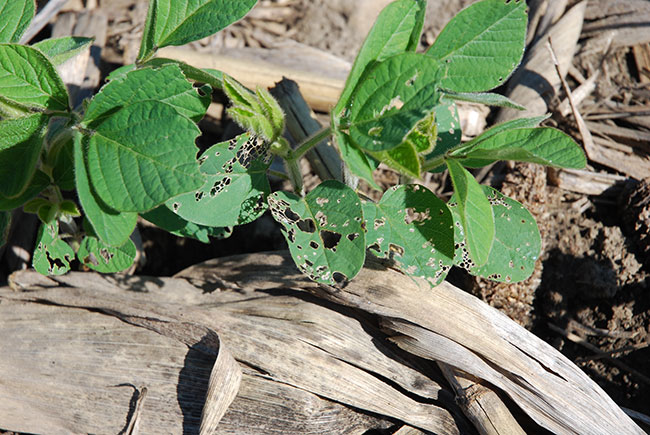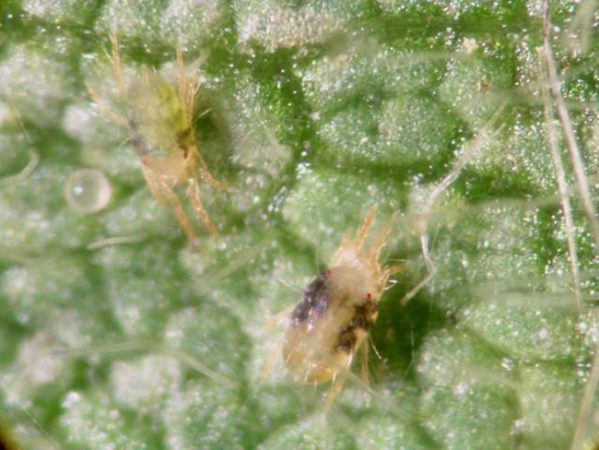
Features
Insect Pests
Soybeans
Twospotted spider mites suck in soybeans
The tiny arachnid causes sporadic damage under hot and dry conditions.
February 19, 2020 By Bruce Barker
 Spider mites caused localized economic damage to
soybeans in 2018 and 2019.
Spider mites caused localized economic damage to
soybeans in 2018 and 2019. How can a tiny mite about 0.4 millimetres long cause economic losses in soybean? They simply suck the life out of the plant, cell by cell. The twospotted spider mite (Tetranychus urticae) feeds on soybeans and many other plants, and populations build under optimum conditions of high temperatures and low humidity. In 2018, and to a lesser extent in 2019, the spider mite caused some localized economic damage to soybeans.
“The twospotted spider mite typically becomes more numerous under drier conditions. Heavy rain can wash them off plants, and wetter conditions allow a fungal pathogen to attack the spider mites to help keep the populations down,” says John Gavloski, Manitoba Agriculture and Resource Development’s entomologist.
The twospotted spider mite goes through four life stages of egg, larva, nymph, and adult. Under optimum conditions of high temperatures and low humidity, the life cycle can be completed in as little as five to seven days, although under normal temperatures and humidity, it usually lasts about 19 days.
The adult twospotted spider mites typically move into soybeans in the spring from grassy waterways, roadsides, and other grassy areas. Mating and egg-laying soon follow and continue throughout the mite’s life. The adult spider mites feed on soybean leaves by piercing leaf cell walls and sucking out the cell’s contents. Extensive damage means the leaf no longer contributes to plant growth and development. In addition to soybeans, they may also be present in dry beans, corn, alfalfa and some vegetables and ornamentals.
Gavloski says feeding damage is most often noticed at field edges, and because the spider mite is so tiny, leaf damage is the first indication of a spider mite infestation. Soybean leaves show a yellow discoloration or stippling. The leaf may have a mottled or sand-blasted appearance and can turn bronze to brown in colour. Field edge infestations may increase after adjacent wheat fields are harvested or if roadside ditches are mowed.

More research is needed to develop action thresholds for the twospotted spider mite in Western Canada.
Photo by John Gavloski.
Other crop stresses such as soybean cyst nematode, nutrient deficiencies and other insects that cause leaf yellowing should be ruled out. While spider mites are very small and can easily be overlooked, which makes field identification difficult, the presence of stippled leaf damage and webbing are clues they may be present. Pulling some of the affected plants and shaking them over a tray or piece of cardboard can help to isolate and increase movement of the twospotted spider mite, which makes them easier to see.
The most susceptible stages of soybean are the R4 (full pod) through R5 (beginning of seed fill). Once soybeans reach R6 (full seed or green bean stage), spider mite feeding will have less impact on yield.
To determine the level of plant injury, sample plants at least 100 feet into the field while walking in a “U” pattern. At 20 different locations, select two plants and look for stippling on the leaves.
More research is needed to develop action thresholds. Gavloski says a widely used nominal action threshold at the R4 to R5 stage is to apply an insecticide when heavy stippling occurs on lower leaves with some stippling progressing into the middle canopy, when mites are present in the middle canopy with scattered colonies in the upper canopy, and when lower leaf yellowing is common.
Dimethoate (Cygon, Lagon) is the only registered insecticide for spider mites in soybean in Canada. It has a 30-day pre-harvest interval. Rather than a blanket application across an entire field, spraying field margins where the insect pressure is usually heaviest might be an option. Dimethoate is a broad-spectrum organophosphate insecticide that can also be damaging to beneficial insects and predators. As a result, Gavloski stresses to only spray once thresholds are reached at the correct stage.
“You might be able to only spray the field edges, and it is important to only spray at the susceptible R4 to R5 stage because, once the crop reaches R6 when the seeds are fully formed, there is less impact from spider mite feeding,” says Gavloski. “And spraying earlier can harm generalist predators, like the lady beetle and minute pirate bugs that feed on spider mites. It’s important to try to encourage those populations by only spraying when necessary.”